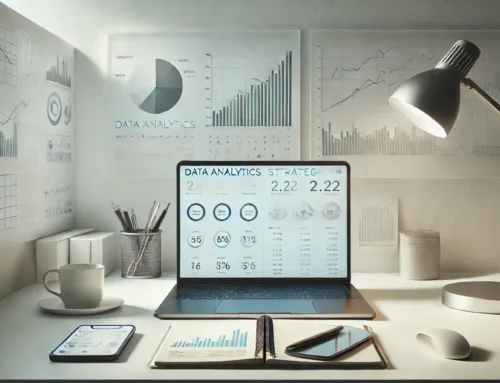You’re tasked with navigating the vast realm of data analytics, and understanding the essential data analytics techniques can be your compass. From uncovering hidden patterns to predicting future trends, these techniques hold the key to unlocking valuable insights. By mastering these tools, you’ll be equipped to unravel complex data puzzles and drive informed decision-making. But, before you dive into the depths of data analytics, let’s unravel the significance of these 10 essential techniques that can shape your analytical journey.
Statistical Analysis
When delving into data analytics, one of the fundamental techniques employed is Statistical Analysis. This technique encompasses various methods such as correlation analysis, outlier detection, hypothesis testing, and data visualization. Correlation analysis is crucial for understanding the relationship between different variables in a dataset. By identifying patterns of association, you can gain insights into how changes in one variable may affect another.
Outlier detection is another vital aspect of Statistical Analysis. It involves identifying data points that deviate significantly from the rest of the dataset. These outliers can have a profound impact on the analysis and should be carefully examined to determine their cause and potential influence on the results.
Hypothesis testing is essential for making inferences about a population based on sample data. By formulating a hypothesis and testing it using statistical methods, you can make informed decisions and draw meaningful conclusions from the data.
Data visualization plays a crucial role in Statistical Analysis by presenting complex data in an easy-to-understand format. Visual representations such as graphs, charts, and dashboards help in identifying trends, patterns, and outliers within the data.
Text Analysis
Text Analysis involves the extraction of valuable insights from unstructured text data. Text Mining focuses on uncovering patterns and trends within large volumes of text, aiding in decision-making processes. Sentiment Analysis, on the other hand, helps in understanding the emotions and opinions expressed in text, providing a deeper understanding of customer feedback and market trends.
Text Mining
Through the process of text mining, data analysts extract valuable insights and patterns from unstructured text data. Keyword extraction involves identifying and analyzing keywords or phrases that are significant in the text, providing a quick overview of its main themes. Topic modeling is a technique that uncovers hidden topics within a set of documents, aiding in organizing and understanding large text datasets. Entity recognition focuses on identifying entities such as names, locations, or dates within the text, enhancing information retrieval and analysis. Document classification categorizes text documents into predefined classes based on their content, enabling easier management and retrieval of information. By applying these text mining techniques, analysts can efficiently sift through vast amounts of unstructured text data, uncovering valuable information that can be used for various purposes such as market research, sentiment analysis, or customer feedback analysis.
Sentiment Analysis
To analyze sentiment in text data, data analysts employ advanced techniques that delve into the emotional tone and attitude expressed in written content. Sentiment analysis plays a crucial role in understanding brand reputation and customer satisfaction. By analyzing the sentiment behind customer reviews, social media interactions, and other textual data, businesses can gain valuable insights into how their brand is perceived in the market. Positive sentiment in customer feedback can indicate high levels of satisfaction and loyalty, while negative sentiment may highlight areas for improvement and potential risks to brand reputation.
Furthermore, sentiment analysis can help businesses track public opinion trends, identify emerging issues, and gauge the effectiveness of marketing campaigns. By harnessing the power of sentiment analysis, organizations can make data-driven decisions to enhance customer experiences, strengthen brand loyalty, and ultimately drive business growth. In today’s digital age, where online reputation can make or break a brand, sentiment analysis has become an indispensable tool for businesses striving to stay competitive and customer-centric.
Multivariate Testing
Utilizing multivariate testing is a powerful method employed in data analytics to analyze multiple variables simultaneously and determine their impact on a desired outcome. Unlike A/B testing, which focuses on comparing two versions of a single variable, multivariate testing allows for a more comprehensive evaluation by considering various combinations of multiple variables. This method is particularly useful in conversion optimization, where subtle changes can significantly impact user behavior and overall outcomes.
Variable selection is a critical aspect of multivariate testing. By carefully choosing which variables to include in the analysis, data analysts can uncover valuable insights into the factors that most strongly influence the desired outcome. Predictive modeling plays a key role in multivariate testing, enabling analysts to not only understand the relationships between variables but also to forecast potential outcomes based on different scenarios.
Cohort Analysis
Cohort analysis is a technique in data analytics that involves grouping users or customers based on shared characteristics or experiences over a specific time frame. This method is crucial for understanding customer behavior and making informed decisions. By utilizing cohort analysis, businesses can delve into various aspects such as cohort retention, churn prediction, customer segmentation, and engagement analysis.
Cohort retention refers to the ability to track and analyze how well cohorts of customers are retained over time. This is essential for identifying trends and patterns that can influence marketing strategies and product offerings. Churn prediction, on the other hand, focuses on forecasting which customers are likely to discontinue using a product or service.
Customer segmentation involves dividing customers into groups based on similarities, enabling companies to tailor their approaches to different segments effectively. Engagement analysis helps in measuring how engaged customers are with a product or service, providing insights into user behavior and preferences. Cohort analysis plays a pivotal role in optimizing business strategies and enhancing customer experiences.
Time-Series Analysis
Time-Series Analysis involves utilizing various pattern detection methods to uncover trends in your data over time. By analyzing historical data, you can forecast future trends and make informed decisions based on these insights. Additionally, examining seasonal impacts within your time-series data can provide valuable information for strategic planning and resource allocation.
Pattern Detection Methods
When analyzing data, one of the crucial aspects to consider is the detection of patterns through Time-Series Analysis. Anomaly detection plays a vital role in identifying unusual data points that deviate from the norm, helping you uncover potential issues or opportunities within your dataset. Utilizing data visualization techniques can assist in displaying these anomalies in a clear and understandable manner, enabling you to take appropriate actions based on the insights gained.
Correlation analysis is another valuable tool in pattern detection, allowing you to understand the relationships between different variables in your dataset. By identifying correlations, you can uncover hidden patterns and dependencies that may influence each other, providing valuable insights for decision-making processes.
Market segmentation is a powerful application of pattern detection methods, where you can group customers based on similar characteristics or behaviors. By analyzing patterns within different market segments, you can tailor your strategies to meet the specific needs and preferences of each group, ultimately improving customer satisfaction and driving business growth.
Forecasting Future Trends
Forecasting future trends through Time-Series Analysis is a critical aspect of data analytics that enables organizations to anticipate upcoming patterns based on historical data. By analyzing past trends, organizations can make informed market predictions and future projections. Time-Series Analysis involves studying data points collected over time to identify patterns, trends, and seasonality, helping organizations make strategic decisions.
Market predictions derived from Time-Series Analysis are essential for businesses to plan their strategies, optimize resources, and stay ahead of the competition. By understanding historical data patterns, organizations can forecast future trends accurately, enabling them to capitalize on opportunities and mitigate risks.
Future projections based on Time-Series Analysis provide valuable insights for businesses looking to understand consumer behavior, demand forecasting, and financial performance. By leveraging this technique, organizations can make data-driven decisions that align with their long-term objectives.
Seasonal Impact Analysis
Analyzing the seasonal impact on data trends plays a vital role in understanding the cyclical patterns that influence business operations. By delving into seasonal impact analysis, you can uncover valuable insights that can guide strategic decision-making and enhance overall performance. Here are some key aspects to consider:
- Holiday Sales: Understanding how holiday seasons affect sales trends is crucial for businesses to capitalize on peak periods and optimize marketing strategies.
- Weather Patterns: Weather fluctuations can significantly impact consumer behavior and demand for certain products or services. Analyzing these patterns can help businesses prepare and respond effectively.
- Inventory Management: Seasonal variations can impact inventory levels, requiring businesses to adjust stocking strategies to meet changing demands.
- Pricing Strategies: Seasonal impact analysis can inform pricing strategies, enabling businesses to adjust prices based on fluctuations in demand during different times of the year.
Regression Analysis
Utilizing regression analysis is a fundamental data analytics technique that allows you to examine the relationship between a dependent variable and one or more independent variables. In predictive modeling, regression analysis helps in understanding how the value of the dependent variable changes when one or more independent variables are varied. By conducting correlation analysis, you can determine the strength and direction of the relationships between variables.
Variable selection is crucial in regression analysis to choose the most relevant independent variables that have a significant impact on the dependent variable. This process helps in building a more accurate and efficient predictive model. Model validation is another essential step in regression analysis, where the performance of the model is assessed to ensure its reliability and effectiveness in making predictions.
Sentiment Analysis
In the realm of data analytics, sentiment analysis is a powerful tool that allows you to detect emotions and mine opinions from vast amounts of textual data. By utilizing sentiment analysis techniques, you can gain valuable insights into how people feel about a particular topic, product, or service. This process enables you to understand and analyze the overall sentiment and attitudes expressed in text data, providing you with a deeper understanding of public opinion.
Emotion Detection
Emotion detection, also known as sentiment analysis, plays a crucial role in data analytics. By recognizing emotions in textual data, businesses can gauge user engagement and customer satisfaction effectively.
- Enhanced User Experience: Emotion recognition allows companies to tailor their products or services to meet the emotional needs of customers, leading to higher user engagement.
- Improved Customer Satisfaction: Through emotion analysis, businesses can identify areas that impact customer sentiment, enabling them to make necessary improvements.
- Predictive Insights: Emotion detection helps in predicting future trends by analyzing the emotional responses of users towards certain products or services.
- Targeted Marketing Strategies: Understanding customer emotions helps in creating targeted marketing campaigns that resonate with the audience, ultimately driving higher customer satisfaction levels.
Emotion detection is a powerful tool that provides valuable insights into customer behavior and sentiment, allowing businesses to make data-driven decisions that enhance user experiences and strengthen customer relationships.
Opinion Mining
For a comprehensive understanding of customer opinions and sentiments, opinion mining, also known as sentiment analysis, is a valuable data analytics technique. By analyzing text data from various sources such as customer reviews, social media posts, and surveys, businesses can gain insights into brand perception and social media sentiment. Opinion mining allows companies to evaluate the overall sentiment towards their products or services, identifying areas of improvement or potential issues that need to be addressed. Through sentiment analysis, organizations can track public perception in real-time, enabling them to respond swiftly to both positive and negative feedback.
Brand perception plays a crucial role in shaping consumer behavior and loyalty. Opinion mining helps businesses gauge how their brand is perceived by the public, allowing them to tailor their marketing strategies accordingly. Social media sentiment analysis, in particular, provides a wealth of data on how customers feel about a brand, helping companies to make informed decisions and enhance their overall reputation.
Neural Networks
Utilizing advanced computational models, Neural Networks form a key component in data analytics techniques. Neural Networks are pivotal in various deep learning applications and play a crucial role in the advancement of image recognition technology.
- Neural Networks are instrumental in deep learning applications, enabling complex tasks like natural language processing and speech recognition.
- They excel in image recognition technology, facilitating tasks such as facial recognition and object detection with remarkable accuracy.
- Neural Networks have the capability to learn patterns and features from vast amounts of data, making them highly effective in predictive analytics and forecasting.
- Their ability to adapt and self-optimize based on data input allows for continuous improvement and refinement in various analytical tasks.
Neural Networks are a cornerstone in modern data analytics, offering powerful tools for processing and understanding complex data sets. By harnessing their capabilities, organizations can unlock valuable insights and drive informed decision-making processes.
Data Clustering
Data clustering is a fundamental technique in data analytics that involves grouping similar data points together based on certain characteristics or features. Cluster visualization techniques help in understanding and interpreting the results of clustering algorithms. These techniques provide visual representations of the clusters, making it easier to identify patterns and relationships within the data. Hierarchical clustering algorithms are a type of clustering method that organizes data points into a tree-like structure. This method creates a hierarchy of clusters where data points are grouped based on their similarity to each other. Hierarchical clustering algorithms can be agglomerative, where each data point starts as its cluster and then clusters are successively merged together, or divisive, where all data points begin in one cluster and are divided into smaller clusters. Understanding and utilizing these clustering techniques can help you uncover valuable insights and patterns within your data, enabling better decision-making processes.
Machine Learning
Machine Learning, a crucial component of data analytics, involves the use of algorithms that enable systems to learn and improve from experience without being explicitly programmed. In the realm of Machine Learning, several key processes play a vital role in achieving accurate and efficient models.
- Feature selection: Choosing the most relevant features to train a model is essential to enhance its performance and prevent overfitting.
- Model evaluation: Assessing the performance of a model using various metrics is crucial to determine its effectiveness and make necessary improvements.
- Hyperparameter tuning: Optimizing the hyperparameters of a model helps in fine-tuning its behavior and enhancing its predictive capabilities.
- Algorithm selection: Selecting the most appropriate algorithm based on the nature of the problem and the available data is fundamental to achieving optimal results.
Frequently Asked Questions
How Can Data Analytics Improve Customer Retention Rates?
To enhance customer retention rates, data analytics leverages predictive modeling and customer segmentation. By analyzing patterns in customer behavior, you can predict future actions, tailor offerings, and personalize experiences, ultimately fostering stronger customer loyalty and satisfaction.
What Are the Ethical Considerations in Data Analytics?
When considering ethical implications in data analytics, it’s crucial to address privacy concerns, data bias, security, and transparency requirements. These factors play a significant role in safeguarding individual rights and ensuring fair and responsible data practices.
What Tools Are Best for Real-Time Data Analysis?
For real-time data analysis, tools like Tableau and Power BI offer intuitive real-time visualization. Combine them with Python for predictive modeling. These tools provide a robust framework for analyzing data swiftly and effectively.
How Can Data Analytics Benefit Small Businesses?
Data analytics can benefit small businesses by providing valuable insights for market analysis and improving sales forecasting. Utilize analytics tools to understand customer behaviors, trends, and preferences, enabling strategic decision-making and maximizing growth opportunities.
What Are the Limitations of Data Analytics in Healthcare?
In healthcare, data privacy is a crucial concern, impacting patient trust and regulatory compliance. Accuracy challenges, such as dealing with vast amounts of diverse data sources, can lead to errors in analysis, affecting patient outcomes and decision-making processes.




